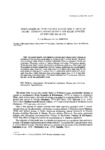Use este identificador para citar ou linkar para este item:
http://www.alice.cnptia.embrapa.br/alice/handle/doc/1068387Registro completo de metadados
| Campo DC | Valor | Idioma |
|---|---|---|
| dc.contributor.author | MORAES, G. J. de | pt_BR |
| dc.contributor.author | McMURTRY, J. A. | pt_BR |
| dc.date.accessioned | 2017-04-11T16:06:11Z | - |
| dc.date.available | 2017-04-11T16:06:11Z | - |
| dc.date.created | 2017-04-11 | pt_BR |
| dc.date.issued | 1985 | pt_BR |
| dc.identifier.citation | Entomophaga, v. 30, n. 4, p. 393-397, 1985. | pt_BR |
| dc.identifier.uri | http://www.alice.cnptia.embrapa.br/alice/handle/doc/1068387 | pt_BR |
| dc.description | Eigth phytoseiid species were tested to evaluate and compare their potential as predators of Tetranychus evansi Baker & Pritchard and T. urticae (Koch). The study was conducted using arenas of excised nightshade (Solanum douglasii Dunal) and Lima Bean (Phaseolus vulagris, L.) leaves infested with either Tetranychus species. When the prey was T. evansi, the predators Amblyseius californicus (McGregor) and Phytoseiulus persimilis Athias-Henriot from Ventura, california, showed the highest oviposition rates. However those rates were 4 to 6 times lower than rates for the same predators feeding on T. urticae. Only A. californicus and the strain of P. persimilis from Beni-Mellal, Morocco, had survivorship higher than 50% 8 days after the beginning of the experiment.The results indicated that T. evansi is an unfavorable prey for all the phytoseiids tested. | pt_BR |
| dc.language.iso | eng | eng |
| dc.rights | openAccess | eng |
| dc.subject | Acaro fitoseideo | pt_BR |
| dc.subject | Comparacao | pt_BR |
| dc.subject | Oviposição | pt_BR |
| dc.subject | Presa | pt_BR |
| dc.subject | Ácaro predador | pt_BR |
| dc.subject | Insect | pt_BR |
| dc.title | Comparison of Tetranychus evansi and T. urticae (Acari: Tetranychidae) as prey for eight species of phytoseiid mites. | pt_BR |
| dc.type | Artigo de periódico | pt_BR |
| dc.date.updated | 2017-04-11T16:06:11Z | pt_BR |
| dc.subject.thesagro | Ácaro | pt_BR |
| dc.subject.thesagro | Inseto | pt_BR |
| dc.subject.thesagro | Tomate | pt_BR |
| dc.subject.thesagro | Controle Biológico | pt_BR |
| dc.subject.thesagro | Tetranychus Urticae | pt_BR |
| dc.subject.thesagro | Sobrevivência | pt_BR |
| dc.subject.thesagro | Tetranychidae | pt_BR |
| dc.subject.nalthesaurus | Acari | pt_BR |
| dc.subject.nalthesaurus | Amblyseius | pt_BR |
| dc.subject.nalthesaurus | Typhlodromus | pt_BR |
| dc.subject.nalthesaurus | Phytoseiidae | pt_BR |
| dc.subject.nalthesaurus | Phytoseiulus | pt_BR |
| dc.subject.nalthesaurus | Phytoseius | pt_BR |
| dc.subject.nalthesaurus | Tetranychus evansi | pt_BR |
| riaa.ainfo.id | 1068387 | pt_BR |
| riaa.ainfo.lastupdate | 2017-04-11 | pt_BR |
| dc.contributor.institution | GILBERTO JOSE DE MORAES, CPATSA; UNIVERSITY OF CALIFORNIA/USA. | pt_BR |
| Aparece nas coleções: | Artigo em periódico indexado (CPATSA)  | |
Arquivos associados a este item:
| Arquivo | Descrição | Tamanho | Formato | |
|---|---|---|---|---|
| Gilberto1985.pdf | 337.99 kB | Adobe PDF |  Visualizar/Abrir |









